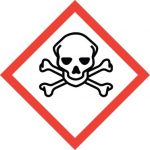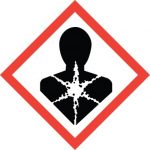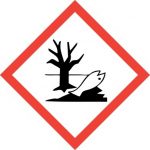1. PRODUCT AND COMPANY IDENTIFICATION
Product identifiers
Product Name: Uranyl Sodium Carbonate
Synonyms: Sodium Uranyl Carbonate
Formula: UO2(CO3)*2NaCO3
CAS RN: [13021-32-4]
Identified Uses: Laboratory chemicals, manufacture of substances.
Supplier
IBI Labs
3495 N. Dixie Hwy. Unit # 8
Boca Raton, FL 33431
Tel: 561-826-0061 Fax: 561-892-8450
Emergency Telephone Numbers
INFOTRAC
USA & Canada contact number: 1-800-535-5053
International contact number: 1-352-323-3500
2. HAZARDS IDENTIFICATION
Classification of The Substance or Mixture
GHS Classification in accordance with 29 CFR 1910 (OSHA HCS):
Acute toxicity, Oral (Category 2), H300
Acute toxicity, Inhalation (Category 2), H330
Specific target organ toxicity – repeated exposure (Category 2), H373
Acute aquatic toxicity (Category 2), H401
Chronic aquatic toxicity (Category 2), H411
For the full text of the H-Statements mentioned in this section, see section 16.
GHS Label Elements, Including Precautionary Statements
Pictogram
Signal word Danger
Hazard statements:
H300 + H330 Fatal if swallowed or if inhaled.
H373 May cause damage to organs through prolonged or repeated exposure.
H411 Toxic to aquatic life with long lasting effects.
Precautionary statements:
P260 Do not breathe dust/fume/gas/mist/vapors/spray.
P264 Wash skin thoroughly after handling.
P270 Do not eat, drink, or smoke when using this product.
P271 Use only outdoors or in a well-ventilated area.
P273 Avoid release to the environment.
P284 Wear respiratory protection.
P301 + P310 If Swallowed: Immediately call a Poison Center or a physician.
P304 + P340 If Inhaled: Remove victim to fresh air and keep at rest in a position comfortable for breathing.
P310 Immediately call a Poison Center or a physician.
P320 Specific treatment is urgent (see supplemental first aid instructions on this label).
P330 Rinse mouth.
P391 Collect spillage.
P403 + P233 Store in a well-ventilated place. Keep container tightly closed.
P405 Store locked up.
P501 Dispose of contents and container to an approved waste disposal plant.
3. COMPOSITION & INFORMATION ON INGREDIENTS
- Description: An odorless to chalky smelling orange-yellow sand-like solid in its pure crystalline form.
- Molecular Weight: 436.02
- Melting Point, ℃: Decomposes at 400℃
- Density: 5.6
4. HAZARDS AND PROTECTION
General advice:
- Consult a physician.
- Show this safety data sheet to the doctor in attendance.
- Move out of dangerous areas.
Storage:
- Protect from physical damage.
- Store in a cool, dry place.
- Protect personnel from radiation emanation if present.
- Separate from other readily oxidizable or combustible materials.
Handling:
- All chemicals should be considered hazardous.
- Avoid direct physical contact.
- Use appropriate, approved safety equipment.
- Untrained individuals should not handle this chemical or its container.
- Handling should occur in a chemical fume hood.
Protection: Approved dust respirator self-contained breathing apparatus; goggles or face shield; protective clothing.
Respirators: Use NIOSH/MSHA-approved respirator appropriate for exposure of concern.
Small spills and leaks:
- Evacuate the area and ventilate.
- Wear protective equipment.
- If required, use an inert absorbent.
- Sweep up and place in an appropriate container for disposal.
- Wash contaminated surfaces.
Incompatibilities:
- Can react with reducing agents to generate heat and products that may be gaseous (causing pressurization of closed containers).
- Can react violently with active metals, cyanides, esters, and thiocyanates.
5. FIREFIGHTING
Extinguishing Media
Suitable extinguishing media: Use water spray, alcohol-resistant foam, dry chemicals, or carbon dioxide.
Special hazards arising from the substance or mixture: Carbon oxides, Uranium oxides.
Advice for firefighters:
- Wear a self-contained breathing apparatus for firefighting if necessary.
- Contain runoff.
6. HEALTH
Exposure Controls
At any detectable concentration: Any self-contained breathing apparatus with a full facepiece operated in a pressure-demand or other positive-pressure mode.
Any supplied-air respirator with a full facepiece operated in a pressure-demand or other positive-pressure mode or other positive-pressure mode with an auxiliary self-contained breathing apparatus operated in pressure-demand or other positive-pressure mode.
Escape – any air-purifying, full-facepiece respirator with a high-efficiency particulate filler.
Any appropriate escape-type, self-contained breathing apparatus.
Firefighting and Other Immediately Dangerous to Life or Health Conditions
Use any self-contained breathing apparatus with a full facepiece respirator and a high-efficiency particulate filter.
Use any supplied-air respirator with a full facepiece operated in a pressure-demand or other positive-pressure mode or other positive-pressure modes with an auxiliary self-contained breathing apparatus operated in pressure-demand or other positive-pressure modes.
Exposure Limits
OSHA: PEL (8 h TWA): 0.05 mg
Exposure Effects: Supra-lethal radiation doses may result in headache, acute brain syndrome, alterations in mental status including coma, and (rarely) seizures within minutes of exposure. Prenatal ionizing radiation exposure may cause
congenital anomalies, mental retardation, and an increased incidence of seizures.
Ingestion: Gastrointestinal syndrome (nausea/vomiting) commonly occurs after doses of 9 to 20 gy and may occur following doses as low as 5 gy. Initial vomiting is followed by persistent diarrhea, which may be bloody.
Inhalation: Pulmonary radiation injury may result in radiation pneumonitis and radiation pulmonary fibrosis.
Skin: Thermonuclear burns may occur. If erythema is produced by penetrating radiation, serious systemic injury is certain.
First Aid
Ingestion:
- Seek medical attention.
- If the patient is drowsy or unconscious, do not give anything by mouth. Place the patient on the left side with the head down.
- Contact a physician, medical facility, or poison control center for advice about whether to induce vomiting.
- If possible, do not leave the patient unattended.
Inhalation:
- Monitoring exposed patients for contamination and decontamination procedures should be started.
- All personnel involved in handling patients should wear disposable protective clothing.
- The patient should be completely undressed and given a soap and water bath or shower (if the patient’s
condition permits and if the facility exists). - Acute inhalation of radionuclides presents some difficult problems.
Skin:
- Remove contaminated clothing.
- Wash the exposed area with soap and water.
- If symptoms persist, seek medical attention.
- Launder clothing before reuse.
Eyes:
- If symptoms develop, immediately move the individual away from exposure and into the fresh air.
- Flush eyes gently with water for at least 15 minutes while holding eyelids apart.
- Seek immediate medical attention.
7. TRANSPORTATION
USCG CHRIS code: URS
The U.S. Department of Transportation (D.O.T.) Code of Federal Regulations (49 CFR Parts 100-185), the International Air Transportation Association (IATA), the International Civil Aviation Organization (ICAO), and the International Maritime Organization (IMDG) are all factored into the classification and transport of material.
Proper Shipping Name:
Hazard Class:
UN/ID Number: To be determined on a case-by-case basis.
Special Information:
Packing Group:
Packing Group:
The classification of substances with multiple hazards must be determined following the criteria presented in the regulations mentioned above. Due to the various quantities and combinations of materials being shipped at one time, the information above must be determined based on the characteristics of the specific shipment.
8. ECOLOGICAL INFORMATION
Other Adverse Effects
- An environmental hazard cannot be excluded in the event of unprofessional handling or disposal.
- Toxic to aquatic life with long-lasting effect.
9. DISCLAIMER AND REFERENCES
Like other actinides, Uranium readily forms a dioxide uranyl core (UO2). This uranyl core readily complexes with carbonate to form charged environmental complexes. Although uranium forms insoluble solids or adsorbs to mineral surfaces at alkaline pH it is these soluble carbonate complexes that increase its solubility, availability, and mobility with low affinities to soil. Uranium(VI) generally forms a pH-dependent suite of uranyl-carbonate complexes in groundwater solutions:
- UO2(OH)2+1
- UO2(CO3)2-2
- UO2(CO3)3-4
- UO2(CO3)(OH)3-1
A common method for concentrating uranium from a solution uses solutions of uranyl carbonates which are passed through a resin bed where the complex ions are transferred to the resin by ion exchange with a negative ion-like chloride. After the buildup of the uranium complex on the resin, the uranium is eluted with a salt solution and the uranium is precipitated in another process.
10. FURTHER INFORMATION
Copyright 2014 IBI Labs. License granted to make unlimited paper copies for internal use only.
IBI Labs requires that those who receive their materials comply with 29 CFR 1910.1200(h), which mandates that employers provide employees with effective information and training about hazardous chemicals in their workplace.
The contents of this document are believed to be accurate as of the date of revision and are provided in good faith. However, it is recommended that recipients use this information as supplementary and exercise caution and judgment regarding its accuracy and suitability. Please note that IBI Labs cannot be held responsible for any damage, direct or indirect, that occurs because of using the information provided in this Safety Data Sheet.
IBI Labs makes no warranties, expressed or implied, including warranties of merchantability and fitness for a particular purpose. This information is provided without warranty, and any use of the product that does not conform to this Safety Data Sheet, or that is used in combination with any other product or process, is the user’s responsibility.
Revision Date: 05/17/2024




